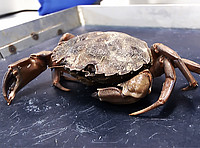The contributions include the personal and individual opinions of students and supervisors. They do not necessarily reflect the opinion of the University of Hohenheim.
“It’s just as important to think about ethical questions as to understand anatomy”

Universities are criticized for the way they handle animals, animal experiments, and dissection courses. The University of Hohenheim would like to state its position and let its students speak for themselves. | more
I think that’s a great idea! It’s definitely a first step toward dealing with this topic. That is why I am happy to write a comment here with my thoughts, experiences, and impressions on this topic / course.
In general, I think the course is very good. It is a great complement to the lecture on Systematic Zoology. It’s good to have a practical part among the many lectures.
It is hands-on and helps us to understand the material better. It is about going through the animal kingdom of recent animals and getting insights into their anatomical structures.
It is not about understanding all the details about all the animals we dissect but about getting an overview of the wide diversity of varying anatomies. In addition, it was shown how the various clades and groups diverged from each other or are related.
For this, we used the following animals as examples:
- Protozoa
- Annelids (earthworm)
- Mollusca (mussels)
- Plathelminthes and Cestoda
- Nematoda and Aschelminthes
- Insecta (roaches)
- Arthropoda (crabs)
- Echinodermata and Chordata
- Osteichthyes (rainbow trout)
- Amphibia (clawed frog)
- Sauropsida (chicks)
- Mammalia (gerbil)
After a theoretical introduction, we had to either cut open dead animals or look at permanent specimens. In addition, sometimes we were shown plastic models. Fresh dissections were earthworms, mussels, roaches, crabs, rainbow trout, clawed frogs, chicks, and mice.
All of the animals except for the crabs came from breeding facilities.
I think it’s good that as aspiring biologists we were given the opportunity to do something practical in our first semester. It is interesting to look at the organs of the different animals.
In my opinion, though, it is absolutely not necessary to prepare so many animals for the course!
I thought it was good that permanent specimens were used. The added practical value is there, but not nearly as many animals have to be killed because permanent specimens can be used repeatedly over a very long period of time.
But if animals are dissected, not nearly so many animals have to die for us students. It would be completely sufficient to work in groups of 4-6 people on one animal.
Biology is the science of life and living beings. Isn’t it just as important to think about ethical questions as to understand anatomy?!
I was disappointed that there was absolutely no critical, questioning discussion about this. We didn’t talk at all about whether it’s right to kill animals so that students can dissect them.
Is it really necessary to kill one earthworm for every two students? Regardless of where they come from. A animal that was bred like the earthworms and that we buy has the same right to life as one that is free!
There are many different opinions on this, and I don’t think that this kind of course should be stopped nor that you should do it without any kind of reflection! I think the first step to handling the topic differently is to talk with the students about ethical questions!
Aïcha, 1st semester, Biology
